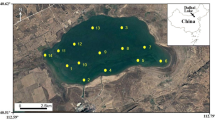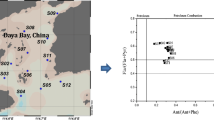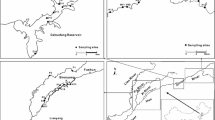Abstract
Sixteen polycyclic aromatic hydrocarbons (PAHs) were analyzed from the surficial sediments in Erhai Lake, a plateau lake in China. The results showed that except for acenaphthylene (Ace) Ace and Dibenz(a,h)anthracene (DBA), the central region contained individual PAHs at concentrations lower than those in other lake regions. Total concentration of the PAHs (ΣPAHs) in the sediments from Erhai Lake ranged from 32.42 to 558.53 mg/kg with a mean value of 256.70 mg/kg. The maximum value of ΣPAHs was observed in the north region of the lake and more than 10-fold higher than the minimum values. Moreover, high molecular weight (HMW) PAHs, especially 5-ring PAHs, accounted for higher ratios up to 76 % relative to other PAHs compound in almost all sampling sites. Molecular diagnostic ratios including anthtacene (Ant)/(Ant + phenanthrene (Phe)), fluoranthene (Flt)/(Flt + pyrene (Pyr)), benz(a)anthracene (BaA)/(BaA + chrysene (Chr)), and indeno(1,2,3-cd)pyrene (IPY)/(IPY + benz(g,h,i)perylene (BPE)) were recorded at all sampling sites and indicated that the origin of PAHs in Erhai Lake was predominately pyrolytic. Furthermore, principal component analysis with component dominating by HMW PAHs showed that combustion origins were the primary contamination sources of PAHs in the sediments of Erhai Lake. Finally, ecological risk assessment indicated that the sediments from Erhai Lake are exposed to potential low risk for ΣPAHs, and the ecological risk decreases in the order of northern region > southern region > central region.





Similar content being viewed by others
References
Andersson M, Klug M, Eggen OA, Ottesen RT (2014) Polycyclic aromatic hydrocarbons (PAHs) in sediments from Lake Lille Lungegårdsvannet in Bergen, western Norway; appraising pollution sources from the urban history. Sci Total Environ 470–471:1160–1172
Arias AH, Vazquez-Botello A, Tombesi N, Ponce-Vélez G, Freije H, Marcovecchio J (2010) Presence, distribution, and origins of polycyclic aromatic hydrocarbons (PAHs) in sediments from Bahía Blanca estuary, Argentina. Environ Monit Assess 160:301–314
Baird WM, Hooven LA, Mahadevan B (2005) Carcinogenic polycyclic aromatic hydrocarbon-DNA adducts and mechanism of action. Environ Mol Mutagen 45:106–114
Bakhtiari AR, Zakaria MP, Yaziz MI, Lajis MNH, Bi XH, Rahim MCA (2009) Vertical distribution and source identification of polycyclic aromatic hydrocarbons in anoxic sediment cores of Chini Lake, Malaysia: perylene as indicator of land plant-derived hydrocarbons. Appl Geochem 24:1777–1787
Barakat AO, Mostafa A, Wade TL, Sweet ST, El Sayed NB (2011) Spatial distribution and temporal trends of polycyclic aromatic hydrocarbons (PAHs) in sediments from Lake Maryut, Alexandria, Egypt. Water Air Soil Poll 218:63–80
Bigus P, Tobiszewski M, Namieśnik J (2014) Historical records of organic pollutants in sediment cores. Mar Pollut Bull 78:26–42
Boffetta P, Jourenkova N, Gustavsson P (1997) Cancer risk from occupational and environmental exposure to polycyclic aromatic hydrocarbons. Cancer Causes Control 8:444–72
Boonyatumanond R, Wattayakorn G, Togo A, Takada H (2006) Distribution and origins of polycyclic aromatic hydrocarbons (PAHs) in riverine, estuarine, and marine sediments in Thailand. Mar Pollut Bull 52:942–956
Brändli RC, Bucheli TD, Kupper T, Mayer J, Stadelmanna FX, Joseph T (2007) Fate of PCBs, PAHs and their source characteristic ratios during composting and digestion of source-separated organic waste in full-scale plants. Environ Pollut 148:520–528
Cao ZG, Liu JL, Luan Y, Li YL, Ma MY, Xu J, Han SL (2010) Distribution and ecosystem risk assessment of polycyclic aromatic hydrocarbons in the Luan River, China. Ecotoxicology 19:827–837
Colombo JC, Cappelletti N, Lasci J, Migoya MC, Speranza E, Skorupka CN (2006) Sources, vertical fluxes, and equivalent toxicity of aromatic hydrocarbons in coastal sediments of the Río de la Plata estuary, Argentina. Environ Sci Technol 40:734–740
Das SK, Routh J, Roychoudhury AN (2008) Sources and historic changes in polycyclic aromatic hydrocarbon input in a shallow lake, Zeekoevlei, South Africa. Org Geochem 39:1109–1112
Dsikowitzky L, Nordhaus I, Jennerjahn TC, Khrycheva P, Sivatharshan Y, Yuwono E, Schwarzbauer J (2011) Anthropogenic organic contaminants in water, sediments and benthic organisms of the mangrove-fringed Segara Anakan Lagoon, Java, Indonesia. Mar Pollut Bull 62:851–862
Feng JL, Zhai MX, Sun JH, Liu Q (2012) Distribution and sources of polycyclic aromatic hydrocarbons (PAHs) in sediment from the upper reach of Huaihe River, East China. Environ Sci Pollut Res 19:1097–1106
Grimalt JO, van Droogea BL, Ribes A, Fernándeza P, Appleby P (2004) Polycyclic aromatic hydrocarbon composition in soils and sediments of high altitude lakes. Environ Pollut 131:13–24
Guo JY, Wu FC, Luo XJ, Liang Z, Liao HQ, Zhang RY, Li W, Zhao XL, Chen SJ, Mai BX (2010) Anthropogenic input of polycyclic aromatic hydrocarbons into five lakes in Western China. Environ Pollut 158:2175–2180
Guo JY, Liang Z, Liao HQ, Tang Z, Zhao XL, Wu FC (2011) Sedimentary record of polycyclic aromatic hydrocarbons in Lake Erhai, Southwest China. J Environ Sci-China 23:1308–1315
Guo JY, Wu FC, Liao HQ, Zhao XL, Li W, Wang J, Wang LF, Giesy JP (2013) Sedimentary record of polycyclic aromatic hydrocarbons and DDTs in Dianchi Lake, an urban lake in Southwest China. Environ Sci Pollut Res 20:5471–5480
Gupta S, Kumar K, Srivastava A, Srivastava A, Jain VK (2011) Size distribution and source apportionment of polycyclic aromatic hydrocarbons (PAHs) in aerosol particle samples from the atmospheric environment of Delhi, India. Sci Total Environ 409:4674–4680
Harrison RM, Smith DTJ, Luhana L (1996) Source apportionment of atmospheric polycyclic aromatic hydrocarbons collected from an urban location in Birmingham, UK. Environ Sci Technol 30:825–832
Hu GC, Luo XJ, Li FC, Dai JY, Guo JY, Chen SJ, Hong C, Mai BX, Xu MQ (2010) Organochlorine compounds and polycyclic aromatic hydrocarbons in surface sediment from Baiyangdian Lake, North China: Concentrations, sources profiles and potential risk. J Environ Sci-China 22:176–183
Kalf DF, Crommentuijn T, Van De Plassche EJ (1997) Environmental quality objectives for 10 polycyclic aromatic hydrocarbons (PAHs). Ecotox Environ Safe 36:89–97
Kalwa M, Quináia SP, Pletsch AL, Torres YR, Finger D (2014) Polycyclic aromatic hydrocarbons in surface sediments of Binacional Itaipu Lake, Brazil: characteristics, sources and toxicity evaluation. Environ Earth Sci 72:4473–4481
Kannan K, Johnson-Restrepo B, Yohn SS, Giesy JP, Long DT (2005) Spatial and temporal distribution of polycyclic aromatic hydrocarbons in sediments from Michigan inland lakes. Environ Sci Technol 39:4700–4706
Katsoyiannis A, Terzi E, Cai QY (2007) On the use of PAH molecular diagnostic ratios in sewage sludge for the understanding of the PAH sources. Is this use appropriate? Chemosphere 69:1337–1339
Ko FC, Baker J, Fang MD, Lee CL (2007) Composition and distribution of polycyclic aromatic hydrocarbons in the surface sediments from the Susquehanna River. Chemosphere 66:277–285
Li JW, Shang X, Zhao ZX, Tanguay RL, Dong QX, Huang CJ (2010) Polycyclic aromatic hydrocarbons in water, sediment, soil, and plants of the Aojiang River waterway in Wenzhou, China. J Hazard Mater 173:75–81
Liu F, Liu JL, Chen QY, Wang BB, Cao ZG (2013) Pollution characteristics and ecological risk of polycyclic aromatic hydrocarbons (PAHs) in surface sediments of the southern part of the Haihe River system in China. Chinese Sci Bull 58:3348–3356
Long ER, MacDonald DD, Smith SL, Calder FD (1995) Incidence of adverse biological effects within ranges of chemical concentrations in marine and estuarine sediments. Environ Manage 19:81–97
Lors C, Damidot D, Ponge J, Périé F (2012) Comparison of a bioremediation process of PAHs in a PAH-contaminated soil at field and laboratory scales. Environ Pollut 165:11–17
Luo XJ, Chen SJ, Mai BX, Yang QS, Sheng GY, Fu JM (2006) Polycyclic aromatic hydrocarbons in suspended particulate matter and sediments from the Pearl River Estuary and adjacent coastal areas, China. Environ Pollut 139:9–20
Lv JP, Xu J, Guo C, Zhang Y, Bai YW, Meng W (2014) Spatial and temporal distribution of polycyclic aromatic hydrocarbons (PAHs) in surface water from Liaohe River Basin, northeast China. Environ Sci Pollut Res 21:7088–7096
Mai BX, Fu JM, Sheng GY, Kang YH, Lin Z, Zhang G, Min YS, Zeng EY (2002) Chlorinated and polycyclic aromatic hydrocarbons in riverine and estuarine sediments from Pearl River Delta, China. Environ Pollut 117:457–474
Martins CC, Bícego MC, Rose NL, Taniguchi S, Lourenço RA, Figueira RC, Mahiques MM, Montone RC (2010) Historical record of polycyclic aromatic hydrocarbons (PAHs) and spheroidal carbonaceous particles (SCPs) in marine sediment cores from Admiralty Bay, King George Island, Antarctica. Environ Pollut 158:192–200
Nakata H, Uehara K, Goto Y, Fukumura M, Shimasaki H, Takikawa K, Miyawaki T (2014) Polycyclic aromatic hydrocarbons in oysters and sediments from the Yatsushiro Sea, Japan: comparison of potential risks among PAHs, dioxins and dioxin-like compounds in benthic organisms. Ecotox Environ Safe 99:61–68
Olivella MÀ (2006) Polycyclic aromatic hydrocarbons in rainwater and surface waters of Lake Maggiore, a subalpine lake in Northern Italy. Chemosphere 63:116–131
Pickard SW, Clarke JU, Lotufo GR (2006) Bioavailability of polycyclic aromatic hydrocarbons (PAHs) from surficial Lake Erie sediments. B Environ Contam Tox 76:791–798
Qin N, He W, Kong XZ, Liu WX, He QS, Yang B, Wang QM, Yang C, Jiang YJ, Jorgensen SE, Xu FL, Zhao XL (2014) Distribution, partitioning and sources of polycyclic aromatic hydrocarbons in the water–SPM–sediment system of Lake Chaohu, China. Sci Total Environ 496:414–423
Sereshk ZH, Bakhtiari A (2014) Distribution patterns of PAHs in different tissues of annulated sea snake (Hydrophis cyanocinctus) and short sea snake (Lapemis curtus) from the Hara Protected Area on the North Coast of the Persian Gulf, Iran. Ecotoxicology and Environmental Safety 109:116–123
Tang Z, Guo JY, Liao HQ, Zhao XL, Wu FC, Zhu YR, Zhang L, Giesy JP (2015) Spatial and temporal distribution and sources of polycyclic aromatic hydrocarbons in sediments of Taihu Lake, eastern China. Environ Sci Pollut Res 22:5350–5358
Ünlü S, Alpar B, Öztürk K, Vardar D (2010) Polycyclic aromatic hydrocarbons (PAHs) in the surficial sediments from Lake Iznik (Turkey): spatial distributions and sources. B Environ Contam Tox 85:573–580
van Drooge BL, López J, Fernández P, Grimalt JO, Stuchlík E (2011) Polycyclic aromatic hydrocarbons in lake sediments from the High Tatras. Environ Pollut 159:1234–1240
Vives I, Grimalt JO, Fernández P, Rosseland B (2004) Polycyclic aromatic hydrocarbons in fish from remote and high mountain lakes in Europe and Greenland. Sci Total Environ 324:67–77
Wan GJ, Bai ZG, Qing H, Mather JD, Huang RG, Wang HR, Tang DG, Xiao BH (2003) Geochemical records in recent sediments of Lake Erhai: implications for environmental changes in a low latitude–high altitude lake in southwest China. J Asian Earth Sci 21:489–502
Wang DQ, Yu YX, Zhang XY, Zhang SH, Pang YP, Zhang XL, Yu ZQ, Wu MH, Fu JM (2012) Polycyclic aromatic hydrocarbons and organochlorine pesticides in fish from Taihu Lake: their levels, sources, and biomagnification. Ecotox Environ Safe 82:63–70
Yan W, Chi JS, Wang ZY, Huang WX, Zhang G (2009) Spatial and temporal distribution of polycyclic aromatic hydrocarbons(PAHs) in sediments from Daya Bay, South China. Environ Pollut 157:1823–1830
Yuan ZJ, Liu GJ, Wang RW, Da CN (2014) Polycyclic aromatic hydrocarbons in sediments from the Old Yellow River Estuary, China: occurrence, sources, characterization and correlation with the relocation history of the Yellow River. Ecotox Environ Safe 109:169–176
Yunker MB, Macdonald RW, Vingarzan R, Mitchell RH, Goyette D, Sylvestre S (2002) PAHs in the Fraser River basin: a critical appraisal of PAH ratios as indicators of PAH source and composition. Org Geochem 33:489–515
Zakaria MP, Takada H, Tsutsumi S, Ohno K, Yamada J, Kouno E, Kumata H (2002) Distribution of polycyclic aromatic hydrocarbons (PAHs) in rivers and estuaries in Malaysia: a widespread input of petrogenic PAHs. Environ Sci Technol 36:1907–1918
Zhang RY, Wang LY, Wu FC, Song BA (2013) Phosphorus speciation in the sediment profile of Lake Erhai, southwestern China: fractionation and 31P NMR. J Environ Sci-China 25:1124–1130
Zhang GZ, Pan ZK, Wang XM, Mo XJ, Li XM (2015) Distribution and accumulation of polycyclic aromatic hydrocarbons (PAHs) in the food web of Nansi Lake, China. Environ Monit Assess. doi:10.1007/s10661-015-4362-4
Zhao ZH, Zhang L, Cai YJ, Chen YW (2014) Distribution of polycyclic aromatic hydrocarbon (PAH) residues in several tissues of edible fishes from the largest freshwater lake in China, Poyang Lake, and associated human health risk assessment. Ecotox Environ Safe 104:323–331
Zheng GD, Bokuichiro T, Akihito K, Motoyuki M (2001) Iron speciation in modern sediment from Erhai Lake, southwestern China Redox conditions in an ancient environment. Appl Geochem 16:1201–1213
Zheng X, Han BP, Thavamani P, Duan LC, Naidu R (2015) Composition, source identification and ecological risk assessment of polycyclic aromatic hydrocarbons in surface sediments of the Subei Grand Canal, China. Environ Earth Sci 74:2669–2677
Acknowledgements
This work was funded by National Basic Technological Research of China (2014FY110400), National Natural Science Foundation of China (no. 41271214), A Project Funded by the Priority Academic Program Development of Jiangsu Higher Education Institutions (PAPD) and State Key Laboratory of Lake Science and Environment (2014SKL014).
Author information
Authors and Affiliations
Corresponding authors
Additional information
Responsible editor: Ester Heath
Rights and permissions
About this article
Cite this article
Hezhong, Y., Enlou, Z., Qi, L. et al. Sources appointment and ecological risk assessment of polycyclic aromatic hydrocarbons (PAHs) in sediments of Erhai Lake, a low-latitude and high-altitude lake in southwest China. Environ Sci Pollut Res 23, 4430–4441 (2016). https://doi.org/10.1007/s11356-015-5626-9
Received:
Accepted:
Published:
Issue Date:
DOI: https://doi.org/10.1007/s11356-015-5626-9




